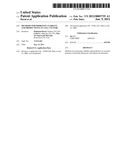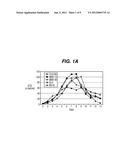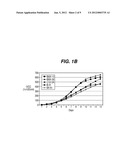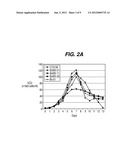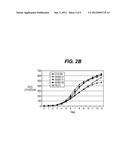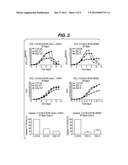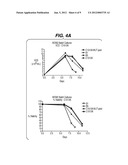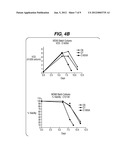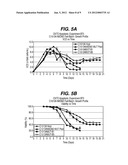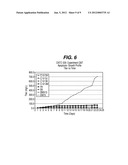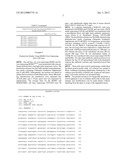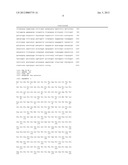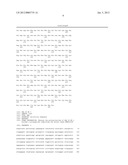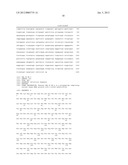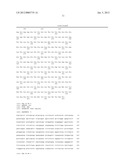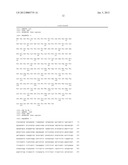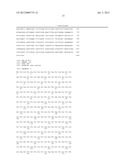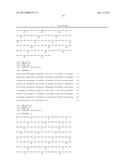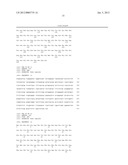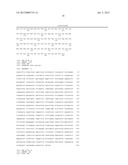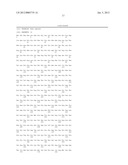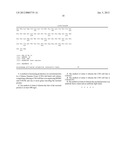Patent application title: Methods for Improving Viability and Productivity in Cell Culture
Inventors:
Haimanti Dorai (Radnor, PA, US)
Celia Ly (Malvern, PA, US)
Tina M. Sauerwald Mcclain (Royersford, PA, US)
IPC8 Class:
USPC Class:
435358
Class name: Animal cell, per se (e.g., cell lines, etc.); composition thereof; process of propagating, maintaining or preserving an animal cell or composition thereof; process of isolating or separating an animal cell or composition thereof; process of preparing a composition containing an animal cell; culture media therefore rodent cell, per se chinese hamster ovary (i.e., cho)
Publication date: 2012-01-05
Patent application number: 20120003735
Abstract:
Methods for increasing viability and production of secreted proteins in
fed batch eukaryotic cell culture are disclosed.Claims:
1. A method of increasing production of a secreted protein in a Chinese
Hamster Ovary (CHO) fed batch cell culture, comprising culturing a CHO
cell line over-expressing MDM2 and E1B19K and one or more genes encoding
the secreted protein.
2. The method of claim 1 wherein the titer of the secreted protein is at least 600 mg/L.
3. The method of claim 1 wherein the CHO cell line is CHO-K1.
4. The method of claim 1 wherein the CHO cell line is CHO-K1SV.
5. The method of claim 1 wherein the secreted protein is an antibody heavy chain and an antibody light chain.
Description:
CROSS-REFERENCE TO RELATED APPLICATIONS
[0001] This application is a divisional of U.S. application Ser. No. 12/483,658, filed 12 Jun. 2009, currently amended, which claims priority to U.S. Provisional Application Ser. No. 61/061,235, filed 13 Jun. 2008, the entire contents of which is incorporated herein by reference in its entirety.
FIELD OF THE INVENTION
[0002] The present invention relates to methods of increasing viability and production of secreted proteins in fed batch eukaryotic cell culture.
BACKGROUND OF THE INVENTION
[0003] Mammalian cell culture is the system of choice for many recombinant protein production processes due to its ability to produce proteins with proper post-translational modifications. With increasing manufacturing demand, a strong motivation exists to improve process efficiency by increasing product yield. Attaining the grams per liter production levels of biotherapeutics in commercial production processes relies upon the optimization of both mammalian cell culture and engineering methods.
[0004] Inherent in current high density, protein-free mammalian cell cultures is the problem of cell death of which apoptosis can account for up to 80% in a typical fed-batch bioreactor, induced in response to stressors such as nutrient and growth factor deprivation, oxygen depletion, toxin accumulation, and shear stress (Goswami et al., Biotechnol. Bioeng. 62:632-640 (1999)). Apoptosis limits the maximum viable cell density, accelerates the onset of the death phase and potentially decreases heterologous protein yield (Chiang and Sisk, Biotechnol. Bioeng. 91:779-792 (2005); Figueroa et al., Biotechnol. Bioeng. 73:211-222 (2001), Metab. Eng. 5:230-245 (2003), Biotechnol Bioeng. 85:589-600 (2004); Mercille and Massie, Biotechnol. Bioeng. 44:1140-1154 (1994)).
[0005] Apoptosis is a result of a complex network of signaling pathways initiating from both inside and outside the cell, culminating in the activation of caspases that execute the final stages of cell death. Various methods of apoptosis prevention have been used to maintain cell viability during extended production runs in mammalian cell culture (Arden and Betenbaugh, Trends Biotechnol. 22:174-180 (2004); Vives et al., Metab. Eng. 5:124-132 (2003)). Altering the extracellular environment through media supplementation of growth factors, hydrolysates, and limiting nutrients has led to increased protein production and decreased apoptosis (Burteau et al., In Vitro Cell Dev. Biol. Anim. 39:291-296 (2003); Zhang and Robinson, Cytotechnology 48: 59-74 (2005)). Other researchers have turned to chemical and genetic strategies to inhibit the apoptotic signaling cascade from within the cell (Sauerwald et al., Biotechnol. Bioeng. 77:704-716 (2002), Biotechnol. Bioeng. 81:329-340 (2003)). Researchers have found that over-expression of genes found upregulated in cancer cells can prolong viability in cells grown in bioreactors by preventing apoptosis upstream of caspase activation (Goswami et al., supra; Mastrangelo et al., Trends Biotechnol. 16:88-95 (1998); Meents et al., Biotechnol. Bioeng. 80:706-716 (2002); Tey et al., J Biotechnol. 79:147-159 (2000) and Biotechnol. Bioeng. 68:31-43 (2000)).
[0006] The anti-apoptotic genes that function in the mitochondrial apoptotic pathway can be divided into three groups, namely 1) those that act early in the pathway, e.g., members of the Bcl-2 family of proteins; 2) those that act mid-pathway to disrupt or inhibit the apoptosome complex, e.g., Aven and 3) those that act late in the pathway, e.g., caspase inhibitors, XIAP. The functionality of the majority of these genes have been studied by over-expressing them in mammalian expression systems, and in some cases the effect of combined over-expression of two or more genes, each derived from a different part of the pathway has been determined. Examples include 1) the additive effect of Bcl-XL and a deletion mutant of XIAP (XIAPA) in CHO cells (Figueroa et al., Metab. Eng. 5:230-245 (2003)); 2) E1B-19K and Aven in BHK cells (Nivitchanyong et al., Biotechnol. Bioeng. 98:825-841 (2007)) and 3) Bcl-XL, Aven and XIAPA (Sauerwald et al., Biotechnol. Bioeng. 81:329-340 (2003)).
[0007] One of the major activators of the apoptosis cascade is the protein p53. One mechanism by which p53 activates apoptosis is through up-regulation of a subset of pro-apoptosis proteins including BNIP3 (Yasuda et al., J. Biol. Chem. 273:12415-21 (1998)). Therefore, up-regulation of p53 may be one of the principal factors triggering apoptosis. p53 can be degraded in cells through ubiquitin mediated degradation pathway via MDM2 (murine double minute-2 gene) (Bond et al., Current Cancer Drug Target 5:3-8 (2005)). Thus, over-expression of MDM2 has the potential to lower p53 levels and by extension, inhibit apoptosis. Previously, it was shown that in the presence of stress signals, a CHO cell line over-expressing MDM2 could survive longer in culture compared to wild type CHO in batch culture (Arden et al., Biotechnol. Bioeng. 97:601-614 (2007)).
[0008] The various approaches described above to increase protein productivity have succeeded to varying degrees. Nevertheless, there is a continuous need to develop methods to increase protein production, especially in large-scale commercial production.
BRIEF DESCRIPTION OF THE DRAWINGS
[0009] FIG. 1. Growth Profiles of cell lines generated from co-transfection of Bcl-2Δ, MDM-2 and XIAPΔ.
[0010] FIG. 2. Growth Profiles of cell lines generated from co-transfection of Bcl-XL, MDM-2 and XIAPΔ.
[0011] FIG. 3. Growth Profiles of cell lines generated from co-transfection of E1B19K and MDM-2. A) Viable Cell Density; B) Integrated Viable Cell Density; C) Down-regulation of Caspase 3/7
[0012] FIG. 4. Growth profiles of cell lines transfected with MDM2.sup.D300A in shake flask batch culture.
[0013] A. Transfected host was 1013A
[0014] B. Transfected host was C1835A
[0015] FIG. 5. Growth profiles of 1013A cell line transfected with DM2.sup.D300A in shake flask fed-batch culture. A) Viable cell density; B) % viability.
[0016] FIG. 6. Antibody titers during fed batch CHO culture.
SUMMARY OF THE INVENTION
[0017] One aspect of the invention is a method of increasing cell viability in a fed batch mammalian cell culture, comprising culturing a mammalian cell line over-expressing MDM2.sup.D300A.
[0018] Another aspect of the invention is a method of increasing cell viability in a fed batch mammalian cell culture, comprising culturing a mammalian cell line over-expressing MDM2.sup.D300A and E1B19K.
[0019] Another aspect of the invention is a method of increasing production of a secreted protein in a Chinese Hamster Ovary (CHO) fed batch cell culture, comprising culturing a CHO cell line over-expressing MDM2.sup.D300A and one or more genes encoding the secreted protein.
[0020] Another aspect of the invention is a method of increasing production of a secreted protein in a Chinese Hamster Ovary (CHO) fed batch cell culture, comprising culturing a CHO cell line over-expressing MDM2.sup.D300A and E1B19K and one or more genes encoding the secreted protein.
[0021] Another aspect of the invention is a method of increasing production of a secreted protein in a Chinese Hamster Ovary (CHO) fed batch cell culture, comprising culturing a CHO cell line over-expressing MDM2.sup.D300A and E1B19K and one or more genes encoding the secreted protein.
[0022] Another aspect of the invention is an isolated polynucleotide encoding a polypeptide comprising the amino acid sequence shown in SEQ ID NO: 4.
[0023] Another aspect of the invention is an isolated polypeptide comprising a polypeptide having the sequence shown in SEQ ID NO: 4.
DETAILED DESCRIPTION OF THE INVENTION
[0024] All publications, including but not limited to patents and patent applications, cited in this specification are herein incorporated by reference as though fully set forth.
[0025] As used herein and in the claims, the singular forms "a," "and," and "the" include plural reference unless the context clearly dictates otherwise. Thus, for example, reference to "a polypeptide" is a reference to one or more polypeptides and includes equivalents thereof known to those skilled in the art.
[0026] The term MDM2 as used herein refers to human MDM2 (MDM2 p53 binding protein homolog) having a polypeptide sequence shown in GenBank accession number NP--002383 (SEQ ID NOs: 1 and 2).
[0027] The term E1B19K as used herein refers to human E1B19K protein, having a polypeptide sequence shown in GenBank accession number NP--004322 (SEQ ID NOs: 5 and 6).
[0028] The term "apoptoticR genes" as used herein refers to genes encoding proteins that, when over-expressed in a cell, confer increased resistance to cell death when compared to the untransfected cell. Exemplary apoptoticR genes are anti-apoptotic members of the Bcl-2 family, including Bcl-2, Bcl-XL, Blc-w or E1B19K, caspase inhibitors, for example the IAP family (inhibitors of apoptosis), including XIAP and XIAPA, and other proteins involved in cell cycle regulation, for example p27 and MDM2 (Arden et al., BioProcessing J. March/April 23-28 (2004); Sauerwald et al., Bioprocessing J. Summer 2002, 61-68 (2002); Arden et al., Biotechnol. Bioengineer. 97:601-614, (2007)). Cell death can be measured by methods well known in the art, for example by measuring Viable Cell Density (VCD) and percent (%) viability, and by calculating integrated viable cell density (IVCC). Activation of apoptosis can be measured by measuring caspase activity using well known methods.
[0029] The term "polypeptide" means a molecule that comprises at least two amino acid residues linked by a peptide bond to form a polypeptide. Small polypeptides of less than 50 amino acids may be referred to as "peptides". Polypeptides may also be referred as "proteins."
[0030] The term "polynucleotide" means a molecule comprising a chain of nucleotides covalently linked by a sugar-phosphate backbone or other equivalent covalent chemistry. Double and single-stranded DNAs and RNAs are typical examples of polynucleotides.
[0031] The term "complementary sequence" means a second isolated polynucleotide sequence that is antiparallel to a first isolated polynucleotide sequence and that comprises nucleotides complementary to the nucleotides in the first polynucleotide sequence. Typically, such "complementary sequences" are capable of forming a double-stranded polynucleotide molecule such as double-stranded DNA or double-stranded RNA when combined under appropriate conditions with the first isolated polynucleotide sequence.
[0032] The term "vector" means a polynucleotide capable of being duplicated within a biological system or that can be moved between such systems. Vector polynucleotides typically contain elements, such as origins of replication, polyadenylation signal or selection markers, that function to facilitate the duplication or maintenance of these polynucleotides in a biological system. Examples of such biological systems may include a cell, virus, animal, plant, and reconstituted biological systems utilizing biological components capable of duplicating a vector. The polynucleotides comprising a vector may be DNA or RNA molecules or hybrids of these.
[0033] The term "expression vector" means a vector that can be utilized in a biological system or a reconstituted biological system to direct the translation of a polypeptide encoded by a polynucleotide sequence present in the expression vector.
[0034] As used herein, the term "fed batch cell culture" means a cell culture process which is based on feeding of a growth limiting nutrient substrate to the culture. The fed batch strategy is typically used in bio-industrial processes to reach a high cell density in a bioreactor. Numerous strategies have been devised to improve viability and ultimately productivity of fed batch cell cultures. In the present invention, an alternative approach is described, whereby a combination of apoptoticR genes are over-expressed in a host cell. An uxpectedly high increase in the production of secreted proteins was demonstrated by cells engineered to over-express both MDM2 and E1B19K in the light of published results describing that expression of MDM-2 alone increased productivity by maximum of 2-fold (Arden et al., Biotechn. Bioengin. 97:601-614, 2007), and expression of E1B19K, although inhibiting apoptosis and improving cell yields, did not increase production of secreted proteins in a cell (WO2007/124106A2 of Betenbaugh). Further, cell lines generated during the studies described in the Examples below that over-expressed E1B19K only had less than optimal growth properties and low expression levels. Thus, the present invention demonstrated a significant benefit for production of secreted proteins in mammalian cells by co-expressing MDM2 and E1B19K.
[0035] The present invention also describes a non-naturally occurring mutant MDM2, which is useful in the methods of the invention.
[0036] One embodiment of the invention is a method if increasing cell viability in a fed batch mammalian cell culture, comprising culturing a mammalian cell line over-expressing one or more apoptoticR genes and evaluating cell viability.
[0037] The methods of the invention are useful for increasing viability in mammalian fed batch cell culture, such as Chinese Hamster Ovary (CHO) cell culture, myeloma or hybridoma cell culture. In particular, the methods of the invention are useful for increasing the integrated viable cell count (IVCC) of CHO cell cultures. The cell lines useful in the method of the invention express one or more apoptosisR genes. In particular, the genes encoding MDM2 (SEQ ID NOs 1 and 2), MDM2.sup.D300A (SEQ ID NOs 3 and 4), E1B19K (SEQ ID NOs: 5 and 6), Aven (SEQ ID NOs: 7 and 8), Bcl-LX (SEQ ID NO:s 9 and 10), Bcl-2A (SE ID NO: 11 and 12), and XIAPΔ (SEQ ID NOs: 13 and 14) can be used. Expression of the apoptosisR genes can be achieved by transfection techniques known to those skilled in the art. The cell lines generated are superior hosts for the development of production cell lines expressing proteins of interest such as peptides, peptide fusions, growth factors, hormones, antibodies, designed ankyrin repeat proteins (DARPins) and other polypeptides useful for therapeutic, diagnostic or research purposes. CHO cell lines useful in the method of the invention include CHO-K1 (Invitrogen, Carlsbad, Calif.) and CHOK1SV (Lonza Biologics, Slough, UK). Myeloma lines useful in the method of the invention include NS0 and Sp2/0.
[0038] In the present invention, the use of cell lines over-expressing apoptosisR genes allows these cell lines to reach IVCC values about two-fold higher than control cell, increase longevity of fed batch cultures up to 7 days, and improve production of secreted proteins by 2-7 fold. Such improved production is significant and can result in lower production costs for complex biologics and at the same time, generate product of superior quality due to the absence of cell lysis of the non-viable cells, as lysed cells release proteases that degrade product. Accordingly, these lines are superior hosts for the development of production cell lines expressing a protein or proteins of interest. For example, a CHO cell line over-expressing MDM2.sup.D300A reached 2-fold increased IVCC values and survived 7 days longer in culture when compared to control cell line.
[0039] Another embodiment of the invention is a method of increasing production of a secreted protein in a CHO fed batch cell culture, comprising culturing a CHO cell line over-expressing at least one apoptoticR genes and one or more genes encoding the secreted protein, and measuring the titer of the secreted protein. Particulary useful cell lines in the methods of the invention are CHO cell lines over-expressing MDM2 and E1B19K, an a cell line over-expressing MDM2.sup.D300A alone. Use of these cell lines in the methods of the invention resulted in 5- to 7-fold increased titers of secreted proteins in fed batch culture of up to 21 days.
[0040] Over-expression of proteins in a cell can be achieved by well known methods, either transiently or by stable expression (Davis et al., Basic Methods in Molecular Biology, 2nd ed., Appleton & Lange, Norwalk, Conn., 1994; Sambrook et al., Molecular Cloning: A Laboratory Manual, 3rd ed., Cold Spring Harbor Laboratory Press, Cold Spring Harbor, N.Y., 2001).
[0041] The present invention also provides isolated mutant MDM2 polynucleotides, vectors comprising these polynucleotides, isolated host cells, polypeptides obtainable from expression of these polynucleotides, methods for expressing the polypeptides of the invention, and methods of using the polynucleotides and polypeptides of the invention. The compositions and methods of the invention can be used for a variety of specific applications. The polynucleotides and vectors of the invention are useful because they encode mutant MDM2 polypeptides and can be used to express these polypeptides. The mutant MDM2 polypeptides are useful as they can be used to improve cell viability and increase production of secreted proteins in the cell when they are recombinantly overexpressed or introduced by other means into a host animal or tissue.
[0042] One aspect of the invention is an isolated polynucleotide comprising a polynucleotide having the sequence shown in SEQ ID NO: 3 or a complementary sequence thereof. The polynucleotide sequence shown in SEQ ID NO: 3 encodes a polypeptide comprising the mutant human MDM2.sup.D300A. In the MDM2.sup.D300A, a putative caspase cleavage site (AspValProAspCysLysLys) identified in the wild type MDM2 was destroyed to confer MDM2 more resistant to degradation, and further increase MDM2 levels in the cell during culture. The polynucleotides of the invention may be produced by chemical synthesis such as solid phase polynucleotide synthesis on an automated polynucleotide synthesizer. Alternatively, the polynucleotides of the invention may be produced by other techniques such as PCR based duplication, vector based duplication, or restriction enzyme based DNA manipulation techniques. Techniques for producing or obtaining polynucleotides of a given known sequence are well known in the art.
[0043] The polynucleotides of the invention may also comprise at least one non-coding sequence, such as transcribed but not translated sequences, termination signals, ribosome binding sites, mRNA stabilizing sequences, introns and polyadenylation signals. The polynucleotide sequences may also comprise additional sequences encoding additional amino acids. These additional polynucleotide sequences may, for example, encode a marker or tag sequence such as a hexa-histidine peptide (Gentz et al., Proc. Natl. Acad. Sci. (USA) 86:821-284 (1989) or the HA peptide tag (Wilson et al., Cell 37:767-778 (1984)) which facilitate the purification of fused polypeptides.
[0044] Another embodiment of the invention is a vector comprising an isolated polynucleotide having a sequence shown in SEQ ID NO: 3. The vectors of the invention are useful for maintaining polynucleotides, duplicating polynucleotides, or driving expression of a polypeptide encoded by a vector of the invention in biological systems, including reconstituted biological systems. Vectors may be chromosomal-, episomal- and virus-derived such as vectors derived from bacterial plasmids, bacteriophages, transposons, yeast episomes, insertion elements, yeast chromosomal elements, baculoviruses, papova viruses such as SV40, vaccinia viruses, adenoviruses, fowl pox viruses, pseudorabies viruses, picornaviruses and retroviruses and vectors derived from combinations thereof, such as cosmids and phagemids.
[0045] The vectors of the invention can be formulated in microparticles, with adjuvants, lipid, buffer or other excipients as appropriate for a particular application.
[0046] In one embodiment of the invention the vector is an expression vector. Expression vectors typically comprise nucleic acid sequence elements that can control, regulate, cause or permit expression of a polypeptide encoded by such a vector. Such elements may comprise transcriptional enhancer binding sites, RNA polymerase initiation sites, ribosome binding sites, and other sites that facilitate the expression of encoded polypeptides in a given expression system. Such expression systems may be cell-based, or cell-free systems well known in the art. Nucleic acid sequence elements and parent vector sequences suitable for use in the expression of encoded polypeptides are also well known in the art. An exemplary plasmid-derived expression vector useful for expression of the polypeptides of the invention comprises an E. coli origin of replication, an aph(3')-1a kanamycin resistance gene, HCMV immediate early promoter with intron A, a synthetic polyA sequence and a bovine growth hormone terminator. Another exemplary plasmid derived expression vector comprises an E. coli origin of replication, an ant(4')-1a kanamycin resistance gene, Rous sarcoma virus long terminal repeat sequences, HCMV immediate early promoter and an SV40 late polyA sequence.
[0047] Another embodiment of the invention is an isolated host cell comprising a vector of the invention. Representative host cell examples include Archaea cells; bacterial cells such as Streptococci, Staphylococci, Enterococci, E. coli, Streptomyces, cyanobacteria, B. subtilis and S. aureus; fungal cells such as Kluveromyces, Saccharomyces, Basidomycete, Candida albicans or Aspergillus; insect cells such as Drosophila S2 and Spodoptera Sf9; animal cells such as CHO, COS, HeLa, C127, 3T3, BHK, 293, CV-1, Bowes melanoma and myeloma; and plant cells, such as gymnosperm or angiosperm cells. The host cells in the methods of the invention may be provided as individual cells, or populations of cells. Populations of cells may comprise an isolated or cultured population of cells or cells present in a matrix such as a tissue.
[0048] Introduction of a polynucleotide, such as a vector, into a host cell can be effected by methods well known to those skilled in the art (Davis et al., Basic Methods in Molecular Biology, 2nd ed., Appleton & Lange, Norwalk, Conn., 1994; Sambrook et al., Molecular Cloning: A Laboratory Manual, 3rd ed., Cold Spring Harbor Laboratory Press, Cold Spring Harbor, N.Y., 2001). These methods include calcium phosphate transfection, DEAE-Dextran mediated transfection, microinjection, cationic lipid-mediated transfection, electroporation, transduction, scrape loading, ballistic introduction and infection.
[0049] Another embodiment of the invention is an isolated polypeptide comprising a polypeptide having a sequence shown in SEQ ID NO: 4. SEQ ID NO: 4 is a polypeptide comprising variant human MDM2 protein with a D300A substitution. The polypeptides of the invention may be produced by chemical synthesis, such as solid phase peptide synthesis, on an automated peptide synthesizer. Alternatively, the polypeptides of the invention can be obtained from polynucleotides encoding these polypeptides by the use of cell-free expression systems such as reticulocyte lysate based expression systems, wheat germ extract based expression systems, and Escherichia coli extract based expression systems. The polypeptides of the invention can also be obtained by expression and isolation from cells harboring a nucleic acid sequence of the invention by techniques well known in the art, such as recombinant expression of easily isolated affinity labeled polypeptides. Those skilled in the art will recognize other techniques for obtaining the polypeptides of the invention. The polypeptides of the invention may comprise fusion polypeptides comprising a polypeptide of the invention fused with a second polypeptide. Such second polypeptides may be leader or secretory signal sequences, a pre- or pro- or prepro-protein sequence, as well as naturally occurring, or partially synthetic sequences derived in part from a naturally occurring sequence or an entirely synthetic sequence.
[0050] Another embodiment of the invention is a method for expressing a polypeptide comprising the steps of providing a host cell of the invention; culturing the host cell under conditions sufficient for the expression of at least one polypeptide comprising the sequence shown in SEQ ID NO: 4.
[0051] Host cells can be cultured under any conditions suitable for maintaining or propagating a given type of host cell and sufficient for expressing a polypeptide. Culture conditions, media, and related methods sufficient for the expression of polypeptides are well known in the art. For example, many mammalian cell types can be aerobically cultured at 37° C. using appropriately buffered DMEM media while bacterial, yeast and other cell types may be cultured at 37° C. under appropriate atmospheric conditions in LB media.
[0052] In the methods of the invention the expression of a polypeptide can be confirmed using a variety of different techniques well known in the art. For example, expression of MDM2.sup.A300D can be confirmed by Western blot or assaying ability of MDM2.sup.A300D to inhibit caspases.
[0053] The present invention will now be described with reference to the following specific, non-limiting examples.
EXAMPLES
[0054] In the following Examples, CHO cell lines over-expressing apoptoticR genes were analyzed in shake flask cultures for peak viable cell density, longevity, caspase 3/7 activation, and improved production of secreted proteins.
Materials and Methods:
Cell Culture:
[0055] CHOK1SV cell line (Lonza Biologics, Slough, UK), designated as the Control cell line C1013A, and CHOK1 (American Type Culture Collection, Manassas, USA), designated as the Control cell line C1835 were cultured in CD-CHO medium (Cat. No. 10743-011, Invitrogen, Carlsbad, Calif.), containing 30 mM Glucose and supplemented with 6 mM L-Glutamine (Invitrogen Cat. No. 10313-021). In some instances, another animal protein-free medium containing various concentrations including 60 mM glucose (defined as the high glucose medium) was used. Fetal Bovine serum was purchased from Hyclone Labs, Logan, Utah (Cat. No. SH30071.03). Cell cultures were monitored by a Cedex automated cell counting instrument (Innovatis, Germany). Integrated viable cell count (IVCC, cell-day/ml) was calculated using the following formula:
IVCC (d1)=[VCD (d0)+VCD (d1)]/2+VCD (d0),
where VCD=viable cell density
Expression Vectors:
[0056] Coding sequence of Bcl-2Δ (SEQ ID NO: 11) was cloned under the CMV promoter into the pCDNA®3.1(+) vector having Neo®. Coding sequence of Bcl-XL (SEQ ID NO: 9) was cloned under the CMV promoter into the pCDNA®3.1(+) vector having Zeo®. Coding sequence of MDM2 (SEQ ID NO: 3) was cloned under the CMV promoter into the pCDNA®3.1(+) vector having Neo®. pBUDCE4.1 vector designed to constitutively express E1B-19K (EF-1a promoter), either alone or in conjunction with Aven (CMV promoter) has been described (Nivitchanyong et al., Biotechnol. Bioeng. 98:825-841 (2007)). The vector expressing XIAPΔ (CMV promoter) has been described (Sauerwald et al., Biotechnol. Bioeng. 77:704-716 (2002)). MDM2.sup.D300A expression vector was generated by in vitro mutagenesis from the MDM2 expression vector. A model antibody (Ab #1) expression vector was constructed by cloning a heavy and a light chain cDNA into a Glutamine Synthase (GS) expression vector (obtained from Lonza Biologics, Slough, UK, under a research license).
Generation of ApoptoticR Cell Lines:
[0057] An exponential culture of CHOK1SV cell line was transfected with various combinations of expression vectors as shown in Table 1. Transfectomas were selected using a combination of 400 μg/ml hygromycin, 400 μg/ml genticin, or 300 μg/ml Zeocin. About 200 resulting transfectomas were expanded into 24-well plate and caspase 3/7 activity determined by APO-ONE assay (Promega, Madison, Wis.). Two measurements were performed; a) early in growth phase (˜day 3 post-seeding) following treatment with Staurosporine to induce apoptosis; and b) late in growth phase (˜day 10 post-seeding), at which time, a subset of wild-type cells has progressed into apoptosis. Transfectomas that had reduced caspase 3/7 activities in both cases were further expanded and top two to four clones were subjected to shake-flask batch growth profile studies.
[0058] Promising cell lines were cryopreserved. Shake-flask cultures of selected lines were tested for reduced caspase 3 activity by FLOW, using fluorescent-labeled antibodies specific for caspase 3 (BD Bioscience; Cat. #68652X/550557). Selected cell lines were C-coded and submitted for cell banking. These cell lines underwent ten to 15 passage stability testing in the absence of antibiotics, which were used as selection agents. The cell lines generated are shown in Table 1. Expression of each transgene was confirmed in a select set of cell lines by Western blot.
TABLE-US-00001 TABLE 1 Cell line Over-expressed gene B-31 Bcl-2Δ BX-61 Bcl-2Δ and XIAPΔ BMX-13 and BMX-39 Bcl-2Δ, MDM2 and XIAPΔ Bx-51 Bcl-XL BxMX-01, BxMX-11 and BxMX-25 Bcl-XL, MDM2 and XIAPΔ EM-15 and EM-70 E1B19K and MDM2 EAX-197 E1B19K, AVEN and XIAPΔ EA-167 E1B19K and AVEN C1013A none BM MDM2 and Bcl-2Δ; BxM MDM2, Bcl-XL EMX- MDM2, E1B19K, XIAPΔ
Shake-Flask Cultures of ApoptoticR Cell Lines:
[0059] Selected apoptoticR cell lines were cultured in batch mode in CD-CHO medium supplemented with 6 mM Glutamine and the requisite antibiotic selection agent(s). CD-CHO medium is formulated with 30 mM glucose. Additionally, select Ab-expressing cell lines were cultured in a custom formulated animal protein-free medium supplemented with 6 mM glutamine and 60 mM glucose.
Caspase 3/7 Activity Assay:
[0060] About 3×105 cells of each clone were seeded in one ml of growth medium in a 24-well plate. On day 4 (d4) post seeding, about 1×105 cells were transferred in triplicate to a 96 well plate. Staurosprine (2 μM fc) was added and the cells were incubated for 16 h before assaying for caspase3/7 activity by APO-ONE kit (BD Labs). The procedure was repeated on d10, except that Staurosporine was omitted. The clones that had significantly lower caspase3/7 activity on both days were expanded into shake flasks. The apoptoticR nature of the selected clones was confirmed by flow cytometry analysis (see below).
Analysis of ApoptoticR Clones by Flow Cytometry:
[0061] About 1×106 cells from exponential cultures were withdrawn from each shake flask into 24 well plates, incubated with Staurosporine (2 μM fc) for 16h, harvested and washed once in PBS. The cells were then incubated with CytoPerm (Cat. No. 2075KK, BD BioScience) to fix and permeablized them. Following a PBS wash, cells were incubated with FITC-labeled anti-caspase3 (Cat. No. 68654, BD BioScience) antibody before subjecting them to analysis by flow cytometry.
Example 1
Effect of MDM2 on Bcl-2Δ Expressing Cell Lines
[0062] Growth profiles (SF/Batch) of BMX-13 and BMX-39, expressing Bcl-2Δ, MDM2 and XIAPΔ, as well as double transfected cell line BX-61 expressing Bcl-2Δ and XIAPΔ, B-31 expressing Bcl-2Δ alone, and the control C1013A were analyzed. The peak viable cell count (VCD) of the control cell line reached 6×10e6 cellsm/ml whereas those of BMX clones reached about 11×10e6 cells/ml. Cell lines expressing Bcl-2Δ and/or XIAPΔ had intermediate VCD (FIG. 1A). BMX clones had higher integrated viable cell count (IVCC) compared to B-31 or BX-61. BMX-39 had a 44% increase in IVCC over control as compared to 23% for B-31. XIAPΔ had no incremental effect on IVCC when used in conjunction with Bcl-2Δ (FIG. 1B). High IVCC correlates with high viability of cells in the long term culture in a bioreactor, resulting in increased product yields. Further, biopharmaceuticals generated from a production cell line derived from an apoptoticR host cell line may be of superior quality. Cell lines BMX-13 and BMX-39 demonstrated caspase 3/7 downregulation by 10-fold and 16-fold, respectively when compared to the control C1013A, confirming anti-apoptotic effect of the genes in the CHO cell line. B-31 and BX-61 had had 12- and 6-fold downregulation of caspases.
Example 2
Effect of MDM2 on Bcl-XL Expressing Cell Lines
[0063] Growth profiles of triple transfected BxMX-01, BxMX11 and BxMX-25, expressing Bcl-XL, MDM2 and XIAPΔ in comparison to Bx-51 expressing Bcl-XL alone as well as the control cell line C1013 were evaluated. The peak viable cell count (VCD) of control cell line reached 6×10e6 cells/ml whereas those of BxMX clones reached about 12×10e6 cells/ml (FIG. 2A). Cell lines expressing Bcl-XL only had intermediate VCD. For example, the peak VCD of cell line Bx-51 was 10×10e6 cells/ml. BxMX clones had higher IVCC compared to Bx-51 with 34% increase in IVCC over control as compared to 18% for Bx-51 (FIG. 2B). Co-transfection of Bcl-XL and MDM2 only (without XIAPΔ) failed to generate cell lines with higher VCD or extended longevity (data not shown). Thus, XIAPΔ and MDM2 are likely to function synergistically towards achieving the high IVCC observed in BxMX-01, BxMX-11 and BxMX-25 cell lines. Caspase 3/7 activity was down-regulated 7-, 5-, and 8-fold in BxMX-01, BxMx-11 and BxMX-25, respectively, as compared to control C1013A.
Example 3
Effect of MDM2 on E1B19K Expressing Cell Lines
[0064] Growth profiles of EM-15 and EM-70 expressing E1B19K and MDM2 are shown in FIG. 3. For comparison, in a separate experiment, cell lines expressing E1B19K and AVEN (EA-167), or expressing E1B19K, AVEN and XIAPΔ (EAX-197) as well as the transfection host cell line, C1013A were included. The peak viable cell density (VCD) of control cell line reached 6×10e6 cells/ml whereas those of EM clones reached about 12×10e6 cells/ml to 16×10e6 cells/ml. The maximum VCD for EA-167 and EAX-197 was 13.6-13.9×10e6 cells/ml. The EM clones had higher IVCC compared to EA-167 or EAX-197. EM-70 had a 100% increase in IVCC over control as compared to 23% increase over control for EA-167. This data, along with the fact that cell lines expressing E1B19K alone were not sufficient for achieving the high IVCC observed in this experiment (Nivitchanyong et al., Biotechnol Bioeng 98:825-841 (2007)) suggests that MDM2 contributed to the increase in IVCC observed in EM-15 and EM-70 cell lines. Co-transfection of E1B19K, MDM2 and XIAPΔ failed to generate cell lines with higher VCD or IVCC as compared to (data not shown). Caspase 3/7 activity in EM-15 and EM-70 cell lines were 13% and 30%, respectively, from the control C1013A. For comparison, EA-167 and EAX-197 had 37% and 20% of caspase 3/7 activity as that of C1013A control. Apoptosis was also confirmed by FLOW as described above. 91% of control cells were positive for caspase 3/7 whereas 1-30% of cells within cell lines expressing apoptototicR genes were caspase 3/7 positive. Cell lines with the lowest caspase 3/7 activity (eg. B-31) did not necessarily have the highest IVCC.
Example 4
Cloning and Expression of Mutant MDM2
[0065] The vector expressing wild-type human MDM2 full-length cDNA (Genbank Accession M92424.1) was obtained from John Hopkins University. The MDM2.sup.D300A expression vector was generated by in vitro mutagenesis with a mutagenesis primer 5' gctgaagagggcttt gatgtgccggcttgt aaaaaaactatagtg 3' (SEQ ID NO: 15, resulting in a replacement of A at position 899 with C, and in substitution of Aspartic acid for Alanine in the predicted MDM2.sup.D300A protein. The mutagenesis was confirmed by sequencing. The MDM2.sup.D300A DNA sequence is shown in SEQ ID NO: 3 and the predicted MDM2.sup.D300A protein sequence is shown in SEQ ID NO: 4. This new mutant vector as well as its wild-type counterpart was used for transient and stable transfections.
[0066] The MDM2.sup.D300A and MDM2 wild type proteins were transiently expressed in Hek293 cells. Western blot demonstrated presence of higher levels of MDM2.sup.D300A in the cells when compared to the wild type MDM2, suggesting the mutant protein was more resistant to proteolytic degradation than the wild type MDM2.
Example 5
Generation of MDM2.sup.D300A-Expressing Cell Lines
[0067] Stable cell lines over-expressing MDM2.sup.D300A or WT MDM2 proteins were generated as described in Example 1. Two host cell lines, C1013A and C1835A were used. The list of cell lines used in growth profile studies is shown in Table 2.
TABLE-US-00002 TABLE 2 Cell line Host Transfected genes A3 C1013A WT MDM2 A4 C1013A WT MDM2 B1 C1013A MDM2D300A B5 C1013A MDM2D300A C7 C1835A WT MDM2 C8 C1835A WT MDM2 D6 C1835A MDM2D300A D7 C1835A MDM2D300A C1013A Pool of wild-type MDM2 cells C1013A Pool of MDM2A300D cells C1013A none C1835A none EM70 C1013A E1B19K, MDM2 C1013H C1013A Bcl2d C1013J C1013A Bcl-XL C1013K C1013A E1B19K, Aven, XIAPd BMX13 C1013A Bcl-2d, MDM2, XIAPd
Example 6
Effect of MDM2 on Longevity and Viability of CHOK1 Host Cell Lines
[0068] The growth profiles and viability (Shake-Flask/Batch) of C1013A-derived and C1835A-derived cell lines D6, B1 and B5 expressing the MDM2D300A gene are shown in FIG. 4. Using Centocor proprietary protein-free medium, the peak viable cell density (VCD) of C1013A control cell line was 8×106 cells/ml, and that of the C1835A control cell line was 5×106 cells/mL. Cell lines over-expressing MDM2.sup.D300A had increased longevity as compared to the control cell lines. In fed-batch cultures, B1 and B5 cell lines were maintained in culture for up to 20 days, whereas the untransfected host cell as well as the cells derived from bulk selected pool following transfection with MDM2.sup.D300A lost viability by day 14 of the culture (FIG. 5).
Example 7
Stability of the CHO Cell Lines Over-Expressing MDM2
[0069] The C1013A-derived and C1835A-derived CHO cell lines D6 and B5 over-expressing MDM2D300A were subjected to a 15-passage stability study, with and without the selection agent, geniticin. A growth curve study was conducted at the beginning and the end of the stability study for each cell line and peak viable cell density (indicative of cell line stability) was noted. The cultures without geneticin selection and at higher passages had equivalent or higher VCD's and thus can be considered to very stable in the absence of the selection reagent (Table 3).
TABLE-US-00003 TABLE 3 Peak VCD of Cell Lines Over-expressing MDM2.m (15- passage Stability Study) Peak VCD (106/mL) MUT-B5 (-) geneticin (p1) 6.7 MUT-B5 (+) geneticin (p1) 6.4 MUT-B5 (-) geneticin (p15) 9.1 MUT-B5 (+) geneticin (p15) 7.3 MUT-D6 (-) geneticin (p1) 4.6 MUT-D6 (+) geneticin (p1) 4.5 MUT-D6 (-) geneticin (p15) 4.6 MUT-D6 (+) geneticin (p15) 5.4
Example 8
Productivity Studies Using MDM2 Over-Expressing Host Cell Lines
[0070] The cell line, A4, over-expressing MDM2 and B1, over-expressing MDM2.sup.D300A were transfected with a recombinant antibody heavy and light chain expression vector. The transfection mixture was first bulk selected using glutamine-free media containing Glutamine Synthetase supplements and 25 μM MSX. Subsequently, the mixture was plated in methocult for isolation of individual clones. About 100 resulting transfectomas per transfection were expanded into 24-well plate and a 14-day spent titer was measured by nephelometry. The average titers for the MDM2 and MDM2D300A cell lines expressing CNTO328 were 90 mg/L, and significantly higher than that of clones derived from C1013A, which was 21.3 mg/L.
[0071] In a separate experiment, CHOK1SV cells were transfected with MDM2 and E1B19K and one clone, EM70 stably expressing E1B19K and MDM2 was transfected with a recombinant heavy and light chain antibody expression vector (Dorai et al., Biotechnol. Bioeng., 103:592-608 (2009). The transfection mixture was first bulk selected using glutamine-free media containing Glutamine Synthetase supplements and 25 uM MSX. For comparison, several other cell lines including C1013A (control), C1013M, C1013J, C1013K, A4, B5, BMX13. Following bulk selection for 29 days, the surviving cells were subjected to a shake-flask fed-batch study. EM70 provided antibody titers of >700 mg/L on d23 whereas the titers of the remaining cell lines did not exceed 100 mg/L (FIG. 6). An exponential culture of CHOK1SV was transfeced with vectors expressing E1B19K and MDM2. Two days later antibiotic selection protocol was initiated. By day 29, all untransfected cells were eliminated whereas the antibiotic resistant cells (transfected pool) had survived.
[0072] These cells were used for performing a shake-flask fed-batch growth profile study. 2e5 cells/ml was seeded in Mach-1 medium containing supplements. Starting day-2, the cultures were fed daily a nutrient mix of glucose and amino acids. Cell counts and titer was measured daily.
[0073] The present invention now being fully described, it will be apparent to one of ordinary skill in the art that many changes and modifications can be made thereto without departing from the spirit or scope of the appended claims.
Sequence CWU
1
1511476DNAHomo sapiens 1atgtgcaata ccaacatgtc tgtacctact gatggtgctg
taaccacctc acagattcca 60gcttcggaac aagagaccct ggttagacca aagccattgc
ttttgaagtt attaaagtct 120gttggtgcac aaaaagacac ttatactatg aaagaggttc
ttttttatct tggccagtat 180attatgacta aacgattata tgatgagaag caacaacata
ttgtatattg ttcaaatgat 240cttctaggag atttgtttgg cgtgccaagc ttctctgtga
aagagcacag gaaaatatat 300accatgatct acaggaactt ggtagtagtc aatcagcagg
aatcatcgga ctcaggtaca 360tctgtgagtg agaacaggtg tcaccttgaa ggtgggagtg
atcaaaagga ccttgtacaa 420gagcttcagg aagagaaacc ttcatcttca catttggttt
ctagaccatc tacctcatct 480agaaggagag caattagtga gacagaagaa aattcagatg
aattatctgg tgaacgacaa 540agaaaacgcc acaaatctga tagtatttcc ctttcctttg
atgaaagcct ggctctgtgt 600gtaataaggg agatatgttg tgaaagaagc agtagcagtg
aatctacagg gacgccatcg 660aatccggatc ttgatgctgg tgtaagtgaa cattcaggtg
attggttgga tcaggattca 720gtttcagatc agtttagtgt agaatttgaa gttgaatctc
tcgactcaga agattatagc 780cttagtgaag aaggacaaga actctcagat gaagatgatg
aggtatatca agttactgtg 840tatcaggcag gggagagtga tacagattca tttgaagaag
atcctgaaat ttccttagct 900gactattgga aatgcacttc atgcaatgaa atgaatcccc
cccttccatc acattgcaac 960agatgttggg cccttcgtga gaattggctt cctgaagata
aagggaaaga taaaggggaa 1020atctctgaga aagccaaact ggaaaactca acacaagctg
aagagggctt tgatgttcct 1080gattgtaaaa aaactatagt gaatgattcc agagagtcat
gtgttgagga aaatgatgat 1140aaaattacac aagcttcaca atcacaagaa agtgaagact
attctcagcc atcaacttct 1200agtagcatta tttatagcag ccaagaagat gtgaaagagt
ttgaaaggga agaaacccaa 1260gacaaagaag agagtgtgga atctagtttg ccccttaatg
ccattgaacc ttgtgtgatt 1320tgtcaaggtc gacctaaaaa tggttgcatt gtccatggca
aaacaggaca tcttatggcc 1380tgctttacat gtgcaaagaa gctaaagaaa aggaataagc
cctgcccagt atgtagacaa 1440ccaattcaaa tgattgtgct aacttatttc ccctag
14762491PRTMus musculus 2Met Cys Asn Thr Asn Met
Ser Val Pro Thr Asp Gly Ala Val Thr Thr1 5
10 15Ser Gln Ile Pro Ala Ser Glu Gln Glu Thr Leu Val
Arg Pro Lys Pro 20 25 30Leu
Leu Leu Lys Leu Leu Lys Ser Val Gly Ala Gln Lys Asp Thr Tyr 35
40 45Thr Met Lys Glu Val Leu Phe Tyr Leu
Gly Gln Tyr Ile Met Thr Lys 50 55
60Arg Leu Tyr Asp Glu Lys Gln Gln His Ile Val Tyr Cys Ser Asn Asp65
70 75 80Leu Leu Gly Asp Leu
Phe Gly Val Pro Ser Phe Ser Val Lys Glu His 85
90 95Arg Lys Ile Tyr Thr Met Ile Tyr Arg Asn Leu
Val Val Val Asn Gln 100 105
110Gln Glu Ser Ser Asp Ser Gly Thr Ser Val Ser Glu Asn Arg Cys His
115 120 125Leu Glu Gly Gly Ser Asp Gln
Lys Asp Leu Val Gln Glu Leu Gln Glu 130 135
140Glu Lys Pro Ser Ser Ser His Leu Val Ser Arg Pro Ser Thr Ser
Ser145 150 155 160Arg Arg
Arg Ala Ile Ser Glu Thr Glu Glu Asn Ser Asp Glu Leu Ser
165 170 175Gly Glu Arg Gln Arg Lys Arg
His Lys Ser Asp Ser Ile Ser Leu Ser 180 185
190Phe Asp Glu Ser Leu Ala Leu Cys Val Ile Arg Glu Ile Cys
Cys Glu 195 200 205Arg Ser Ser Ser
Ser Glu Ser Thr Gly Thr Pro Ser Asn Pro Asp Leu 210
215 220Asp Ala Gly Val Ser Glu His Ser Gly Asp Trp Leu
Asp Gln Asp Ser225 230 235
240Val Ser Asp Gln Phe Ser Val Glu Phe Glu Val Glu Ser Leu Asp Ser
245 250 255Glu Asp Tyr Ser Leu
Ser Glu Glu Gly Gln Glu Leu Ser Asp Glu Asp 260
265 270Asp Glu Val Tyr Gln Val Thr Val Tyr Gln Ala Gly
Glu Ser Asp Thr 275 280 285Asp Ser
Phe Glu Glu Asp Pro Glu Ile Ser Leu Ala Asp Tyr Trp Lys 290
295 300Cys Thr Ser Cys Asn Glu Met Asn Pro Pro Leu
Pro Ser His Cys Asn305 310 315
320Arg Cys Trp Ala Leu Arg Glu Asn Trp Leu Pro Glu Asp Lys Gly Lys
325 330 335Asp Lys Gly Glu
Ile Ser Glu Lys Ala Lys Leu Glu Asn Ser Thr Gln 340
345 350Ala Glu Glu Gly Phe Asp Val Pro Asp Cys Lys
Lys Thr Ile Val Asn 355 360 365Asp
Ser Arg Glu Ser Cys Val Glu Glu Asn Asp Asp Lys Ile Thr Gln 370
375 380Ala Ser Gln Ser Gln Glu Ser Glu Asp Tyr
Ser Gln Pro Ser Thr Ser385 390 395
400Ser Ser Ile Ile Tyr Ser Ser Gln Glu Asp Val Lys Glu Phe Glu
Arg 405 410 415Glu Glu Thr
Gln Asp Lys Glu Glu Ser Val Glu Ser Ser Leu Pro Leu 420
425 430Asn Ala Ile Glu Pro Cys Val Ile Cys Gln
Gly Arg Pro Lys Asn Gly 435 440
445Cys Ile Val His Gly Lys Thr Gly His Leu Met Ala Cys Phe Thr Cys 450
455 460Ala Lys Lys Leu Lys Lys Arg Asn
Lys Pro Cys Pro Val Cys Arg Gln465 470
475 480Pro Ile Gln Met Ile Val Leu Thr Tyr Phe Pro
485 49031292DNAArtificial SequenceWhereas the
polynucleotide of SEQ ID NO3 encodes a polypeptide comprising the
mutant human MDM2D300A 3atgactaaac gattatatga tgagaagcaa caacatattg
tatattgttc aaatgatctt 60ctaggagatt tgtttggcgt gccaagcttc tctgtgaaag
agcacaggaa aatatatacc 120atgatctaca ggaacttggt agtagtcaat cagcaggaat
catcggactc aggtacatct 180gtgagtgaga acaggtgtca ccttgaaggt gggagtgatc
aaaaggacct tgtacaagag 240cttcaggaag agaaaccttc atcttcacat ttggtttcta
gaccatctac ctcatctaga 300aggagagcaa ttagtgagac agaagaaaat tcagatgaat
tatctggtga acgacaaaga 360aaacgccaca aatctgatag tatttccctt tcctttgatg
aaagcctggc tctgtgtgta 420ataagggaga tatgttgtga aagaagcagt agcagtgaat
ctacagggac gccatcgaat 480ccggatcttg atgctggtgt aagtgaacat tcaggtgatt
ggttggatca ggattcagtt 540tcagatcagt ttagtgtaga atttgaagtt gaatctctcg
actcagaaga ttatagcctt 600agtgaagaag gacaagaact ctcagatgaa gatgatgagg
tatatcaagt tactgtgtat 660caggcagggg agagtgatac agattcattt gaagaagatc
ctgaaatttc cttagctgac 720tattggaaat gcacttcatg caatgaaatg aatccccccc
ttccatcaca ttgcaacaga 780tgttgggccc ttcgtgagaa ttggcttcct gaagataaag
ggaaagataa aggggaaatc 840tctgagaaag ccaaactgga aaactcaaca caagctgaag
agggctttga tgtgccggct 900tgtaaaaaac tatagtgaat gattccagag agtcatgtgt
tgaggaaaat gatgataaaa 960ttacacaagc ttcacaatca caagaaagtg aagactattc
tcagccatca acttctagta 1020gcattattta tagcagccaa gaagatgtga aagagtttga
aagggaagaa acccaagaca 1080aagaagagag tgtggaatct agtttgcccc ttaatgccat
tgaaccttgt gtgatttgtc 1140aaggtcgacc taaaaatggt tgcattgtcc atggcaaaac
aggacatctt atggcctgct 1200ttacatgtgc aaagaagcta aagaaaagga ataagccctg
cccagtatgt agacaaccaa 1260ttcaaatgat tgtgctaact tatttcccct ag
12924430PRTArtificial SequenceWhereas SEQ ID NO4 is
a polypeptide comprising variant human MDM2 protein with a D300A
substitution 4Met Thr Lys Arg Leu Tyr Asp Glu Lys Gln Gln His Ile Val Tyr
Cys1 5 10 15Ser Asn Asp
Leu Leu Gly Asp Leu Phe Gly Val Pro Ser Phe Ser Val 20
25 30Lys Glu His Arg Lys Ile Tyr Thr Met Ile
Tyr Arg Asn Leu Val Val 35 40
45Val Asn Gln Gln Glu Ser Ser Asp Ser Gly Thr Ser Val Ser Glu Asn 50
55 60Arg Cys His Leu Glu Gly Gly Ser Asp
Gln Lys Asp Leu Val Gln Glu65 70 75
80Leu Gln Glu Glu Lys Pro Ser Ser Ser His Leu Val Ser Arg
Pro Ser 85 90 95Thr Ser
Ser Arg Arg Arg Ala Ile Ser Glu Thr Glu Glu Asn Ser Asp 100
105 110Glu Leu Ser Gly Glu Arg Gln Arg Lys
Arg His Lys Ser Asp Ser Ile 115 120
125Ser Leu Ser Phe Asp Glu Ser Leu Ala Leu Cys Val Ile Arg Glu Ile
130 135 140Cys Cys Glu Arg Ser Ser Ser
Ser Glu Ser Thr Gly Thr Pro Ser Asn145 150
155 160Pro Asp Leu Asp Ala Gly Val Ser Glu His Ser Gly
Asp Trp Leu Asp 165 170
175Gln Asp Ser Val Ser Asp Gln Phe Ser Val Glu Phe Glu Val Glu Ser
180 185 190Leu Asp Ser Glu Asp Tyr
Ser Leu Ser Glu Glu Gly Gln Glu Leu Ser 195 200
205Asp Glu Asp Asp Glu Val Tyr Gln Val Thr Val Tyr Gln Ala
Gly Glu 210 215 220Ser Asp Thr Asp Ser
Phe Glu Glu Asp Pro Glu Ile Ser Leu Ala Asp225 230
235 240Tyr Trp Lys Cys Thr Ser Cys Asn Glu Met
Asn Pro Pro Leu Pro Ser 245 250
255His Cys Asn Arg Cys Trp Ala Leu Arg Glu Asn Trp Leu Pro Glu Asp
260 265 270Lys Gly Lys Asp Lys
Gly Glu Ile Ser Glu Lys Ala Lys Leu Glu Asn 275
280 285Ser Thr Gln Ala Glu Glu Gly Phe Asp Val Pro Ala
Cys Lys Lys Thr 290 295 300Ile Val Asn
Asp Ser Arg Glu Ser Cys Val Glu Glu Asn Asp Asp Lys305
310 315 320Ile Thr Gln Ala Ser Gln Ser
Gln Glu Ser Glu Asp Tyr Ser Gln Pro 325
330 335Ser Thr Ser Ser Ser Ile Ile Tyr Ser Ser Gln Glu
Asp Val Lys Glu 340 345 350Phe
Glu Arg Glu Glu Thr Gln Asp Lys Glu Glu Ser Val Glu Ser Ser 355
360 365Leu Pro Leu Asn Ala Ile Glu Pro Cys
Val Ile Cys Gln Gly Arg Pro 370 375
380Lys Asn Gly Cys Ile Val His Gly Lys Thr Gly His Leu Met Ala Cys385
390 395 400Phe Thr Cys Ala
Lys Lys Leu Lys Lys Arg Asn Lys Pro Cys Pro Val 405
410 415Cys Arg Gln Pro Ile Gln Met Ile Val Leu
Thr Tyr Phe Pro 420 425
4305660DNAHomo sapiens 5atgtcgtccc acctagtcga gccgccgccg cccctgcaca
acaacaacaa caactgcgag 60gaaaatgagc agtctctgcc cccgccggcc ggcctcaaca
gttcctgggt ggagctaccc 120atgaacagca gcaatggcaa tgataatggc aatgggaaaa
atggggggct ggaacacgta 180ccatcctcat cctccatcca caatggagac atggagaaga
ttcttttgga tgcacaacat 240gaatcaggac agagtagttc cagaggcagt tctcactgtg
acagcccttc gccacaagaa 300gatgggcaga tcatgtttga tgtggaaatg cacaccagca
gggaccatag ctctcagtca 360gaagaagaag ttgtagaagg agagaaggaa gtcgaggctt
tgaagaaaag tgcggactgg 420gtatcagact ggtccagtag acccgaaaac attccaccca
aggagttcca cttcagacac 480cctaaacgtt ctgtgtcttt aagcatgagg aaaagtggag
ccatgaagaa agggggtatt 540ttctccgcag aatttctgaa ggtgttcatt ccatctctct
tcctttctca tgttttggct 600ttggggctag gcatctatat tggaaagcga ctgagcacac
cctctgccag cacctactga 6606219PRTHomo sapiens 6Met Ser Ser His Leu Val
Glu Pro Pro Pro Pro Leu His Asn Asn Asn1 5
10 15Asn Asn Cys Glu Glu Asn Glu Gln Ser Leu Pro Pro
Pro Ala Gly Leu 20 25 30Asn
Ser Ser Trp Val Glu Leu Pro Met Asn Ser Ser Asn Gly Asn Asp 35
40 45Asn Gly Asn Gly Lys Asn Gly Gly Leu
Glu His Val Pro Ser Ser Ser 50 55
60Ser Ile His Asn Gly Asp Met Glu Lys Ile Leu Leu Asp Ala Gln His65
70 75 80Glu Ser Gly Gln Ser
Ser Ser Arg Gly Ser Ser His Cys Asp Ser Pro 85
90 95Ser Pro Gln Glu Asp Gly Gln Ile Met Phe Asp
Val Glu Met His Thr 100 105
110Ser Arg Asp His Ser Ser Gln Ser Glu Glu Glu Val Val Glu Gly Glu
115 120 125Lys Glu Val Glu Ala Leu Lys
Lys Ser Ala Asp Trp Val Ser Asp Trp 130 135
140Ser Ser Arg Pro Glu Asn Ile Pro Pro Lys Glu Phe His Phe Arg
His145 150 155 160Pro Lys
Arg Ser Val Ser Leu Ser Met Arg Lys Ser Gly Ala Met Lys
165 170 175Lys Gly Gly Ile Phe Ser Ala
Glu Phe Leu Lys Val Phe Ile Pro Ser 180 185
190Leu Phe Leu Ser His Val Leu Ala Leu Gly Leu Gly Ile Tyr
Ile Gly 195 200 205Lys Arg Leu Ser
Thr Pro Ser Ala Ser Thr Tyr 210 21571089DNAHomo
sapiens 7atgcaggcgg agcgaggagc tcggggaggc cgtgggcggc ggccaggccg
cggccggcct 60ggcggagatc gccacagcga gcggcccgga gccgcagcgg cggtagccag
aggcggcggc 120ggaggcggcg gcggggacgg aggcggacgc cggggccgtg gccgtggccg
gggcttccgc 180ggcgctcgcg gaggccgagg aggaggaggc gccccgcgag gcagccgccg
ggagccggga 240ggctggggcg caggggccag cgcgccggtt gaagatgaca gcgatgcaga
gacctatgga 300gaagagaatg atgaacaggg aaattattct aaaagaaaga ttgtctctaa
ctgggatcga 360tatcaagata ttgaaaaaga ggtcaataat gaaagtggag agtcacagag
gggaacagat 420ttcagtgtcc tccttagctc tgcaggggac tcattctcac agttccggtt
tgctgaggag 480aaagaatggg atagtgaagc ttcttgtcca aaacagaatt cagcatttta
tgtggatagt 540gagttattgg ttcgagccct tcaagagctg cctctctgcc tccgactcaa
cgttgctgcc 600gaactggtcc agggtacagt tcctttagag gttcctcagg tgaaaccaaa
gagaactgat 660gatggcaagg gattagggat gcagttaaag gggcccttgg ggcctggagg
aagggggccc 720atctttgagc tgaaatctgt ggctgctggc tgccctgtgt tgctgggcaa
agacaaccca 780agcccgggtc cttcaaggga ttctcagaaa cccacttccc cactgcagtc
agcaggagac 840catttggaag aagaactaga tctgttgctt aatttagatg cacctataaa
agagggagat 900aacatcttac cagatcagac gtctcaggac ctgaaatcca aggaagatgg
ggaggtggtc 960caagaggaag aagtttgtgc aaaaccatct gtgactgaag aaaaaaacat
ggaacctgag 1020caaccaagta cctccaaaaa tgttaccgag gaagagctgg aagactggtt
ggacagcatg 1080atttcctaa
10898362PRTHomo sapiens 8Met Gln Ala Glu Arg Gly Ala Arg Gly
Gly Arg Gly Arg Arg Pro Gly1 5 10
15Arg Gly Arg Pro Gly Gly Asp Arg His Ser Glu Arg Pro Gly Ala
Ala 20 25 30Ala Ala Val Ala
Arg Gly Gly Gly Gly Gly Gly Gly Gly Asp Gly Gly 35
40 45Gly Arg Arg Gly Arg Gly Arg Gly Arg Gly Phe Arg
Gly Ala Arg Gly 50 55 60Gly Arg Gly
Gly Gly Gly Ala Pro Arg Gly Ser Arg Arg Glu Pro Gly65 70
75 80Gly Trp Gly Ala Gly Ala Ser Ala
Pro Val Glu Asp Asp Ser Asp Ala 85 90
95Glu Thr Tyr Gly Glu Glu Asn Asp Glu Gln Gly Asn Tyr Ser
Lys Arg 100 105 110Lys Ile Val
Ser Asn Trp Asp Arg Tyr Gln Asp Ile Glu Lys Glu Val 115
120 125Asn Asn Glu Ser Gly Glu Ser Gln Arg Gly Thr
Asp Phe Ser Val Leu 130 135 140Leu Ser
Ser Ala Gly Asp Ser Phe Ser Gln Phe Arg Phe Ala Glu Glu145
150 155 160Lys Glu Trp Asp Ser Glu Ala
Ser Cys Pro Lys Gln Asn Ser Ala Phe 165
170 175Tyr Val Asp Ser Glu Leu Leu Val Arg Ala Leu Gln
Glu Leu Pro Leu 180 185 190Cys
Leu Arg Leu Asn Val Ala Ala Glu Leu Val Gln Gly Thr Val Pro 195
200 205Leu Glu Val Pro Gln Val Lys Pro Lys
Arg Thr Asp Asp Gly Lys Gly 210 215
220Leu Gly Met Gln Leu Lys Gly Pro Leu Gly Pro Gly Gly Arg Gly Pro225
230 235 240Ile Phe Glu Leu
Lys Ser Val Ala Ala Gly Cys Pro Val Leu Leu Gly 245
250 255Lys Asp Asn Pro Ser Pro Gly Pro Ser Arg
Asp Ser Gln Lys Pro Thr 260 265
270Ser Pro Leu Gln Ser Ala Gly Asp His Leu Glu Glu Glu Leu Asp Leu
275 280 285Leu Leu Asn Leu Asp Ala Pro
Ile Lys Glu Gly Asp Asn Ile Leu Pro 290 295
300Asp Gln Thr Ser Gln Asp Leu Lys Ser Lys Glu Asp Gly Glu Val
Val305 310 315 320Gln Glu
Glu Glu Val Cys Ala Lys Pro Ser Val Thr Glu Glu Lys Asn
325 330 335Met Glu Pro Glu Gln Pro Ser
Thr Ser Lys Asn Val Thr Glu Glu Glu 340 345
350Leu Glu Asp Trp Leu Asp Ser Met Ile Ser 355
3609513DNAHomo sapiens 9atgtctcaga gcaaccggga gctggtggtt
gactttctct cctacaagct ttcccagaaa 60ggatacagct ggagtcagtt tagtgatgtg
gaagagaaca ggactgaggc cccagaaggg 120actgaatcgg agatggagac ccccagtgcc
atcaatggca acccatcctg gcacctggca 180gacagccccg cggtgaatgg agccactggc
cacagcagca gtttggatgc ccgggaggtg 240atccccatgg cagcagtaaa gcaagcgctg
agggaggcag gcgacgagtt tgaactgcgg 300taccggcggg cattcagtga cctgacatcc
cagctccaca tcaccccagg gacagcatat 360cagagctttg aacaggatac ttttgtggaa
ctctatggga acaatgcagc agccgagagc 420cgaaagggcc aggaacgctt caaccgctgg
ttcctgacgg gcatgactgt ggccggcgtg 480gttctgctgg gctcactctt cagtcggaaa
tga 51310233PRTHomo sapiens 10Met Ser Gln
Ser Asn Arg Glu Leu Val Val Asp Phe Leu Ser Tyr Lys1 5
10 15Leu Ser Gln Lys Gly Tyr Ser Trp Ser
Gln Phe Ser Asp Val Glu Glu 20 25
30Asn Arg Thr Glu Ala Pro Glu Gly Thr Glu Ser Glu Met Glu Thr Pro
35 40 45Ser Ala Ile Asn Gly Asn Pro
Ser Trp His Leu Ala Asp Ser Pro Ala 50 55
60Val Asn Gly Ala Thr Gly His Ser Ser Ser Leu Asp Ala Arg Glu Val65
70 75 80Ile Pro Met Ala
Ala Val Lys Gln Ala Leu Arg Glu Ala Gly Asp Glu 85
90 95Phe Glu Leu Arg Tyr Arg Arg Ala Phe Ser
Asp Leu Thr Ser Gln Leu 100 105
110His Ile Thr Pro Gly Thr Ala Tyr Gln Ser Phe Glu Gln Val Val Asn
115 120 125Glu Leu Phe Arg Asp Gly Val
Asn Trp Gly Arg Ile Val Ala Phe Phe 130 135
140Ser Phe Gly Gly Ala Leu Cys Val Glu Ser Val Asp Lys Glu Met
Gln145 150 155 160Val Leu
Val Ser Arg Ile Ala Ala Trp Met Ala Thr Tyr Leu Asn Asp
165 170 175His Leu Glu Pro Trp Ile Gln
Glu Asn Gly Gly Trp Asp Thr Phe Val 180 185
190Glu Leu Tyr Gly Asn Asn Ala Ala Ala Glu Ser Arg Lys Gly
Gln Glu 195 200 205Arg Phe Asn Arg
Trp Phe Leu Thr Gly Met Thr Val Ala Gly Val Val 210
215 220Leu Leu Gly Ser Leu Phe Ser Arg Lys225
23011573DNAHomo sapiens 11atggcgcacg ctgggagaac agggtacgat aaccgggaga
tagtgatgaa gtacatccat 60tataagctgt cgcagagggg ctacgagtgg gatgccgcgg
ggcctgcgct cagcccggtg 120ccacctgtgg tccacctgac cctccgccag gccggcgacg
acttctcccg ccgctaccgc 180cgcgacttcg ccgagatgtc cagccagctg cacctgacgc
ccttcaccgc gcggggacgc 240tttgccacgg tggtggagga gctcttcagg gacggggtga
actgggggag gattgtggcc 300ttctttgagt tcggtggggt catgtgtgtg gagagcgtca
accgggagat gtcgcccctg 360gtggacaaca tcgccctgtg gatgactgag tacctgaacc
ggcacctgca cacctggatc 420caggataacg gaggctggga tgcctttgtg gaactgtacg
gccccagcat gcggcctctg 480tttgatttct cctggctgtc tctgaagact ctgctcagtt
tggccctggt gggagcttgc 540atcaccctgg gtgcctatct gagccacaag tga
57312190PRTHomo sapiens 12Met Ala His Ala Gly Arg
Thr Gly Tyr Asp Asn Arg Glu Ile Val Met1 5
10 15Lys Tyr Ile His Tyr Lys Leu Ser Gln Arg Gly Tyr
Glu Trp Asp Ala 20 25 30Ala
Gly Pro Ala Leu Ser Pro Val Pro Pro Val Val His Leu Thr Leu 35
40 45Arg Gln Ala Gly Asp Asp Phe Ser Arg
Arg Tyr Arg Arg Asp Phe Ala 50 55
60Glu Met Ser Ser Gln Leu His Leu Thr Pro Phe Thr Ala Arg Gly Arg65
70 75 80Phe Ala Thr Val Val
Glu Glu Leu Phe Arg Asp Gly Val Asn Trp Gly 85
90 95Arg Ile Val Ala Phe Phe Glu Phe Gly Gly Val
Met Cys Val Glu Ser 100 105
110Val Asn Arg Glu Met Ser Pro Leu Val Asp Asn Ile Ala Leu Trp Met
115 120 125Thr Glu Tyr Leu Asn Arg His
Leu His Thr Trp Ile Gln Asp Asn Gly 130 135
140Gly Trp Asp Ala Phe Val Glu Leu Tyr Gly Pro Ser Met Arg Pro
Leu145 150 155 160Phe Asp
Phe Ser Trp Leu Ser Leu Lys Thr Leu Leu Ser Leu Ala Leu
165 170 175Val Gly Ala Cys Ile Thr Leu
Gly Ala Tyr Leu Ser His Lys 180 185
190131356DNAHomo sapiens 13atgactttta acagttttga aggatctaaa
acttgtgtac ctgcagacat caataaggaa 60gaagaatttg tagaagagtt taatagatta
aaaacttttg ctaattttcc aagtggtagt 120cctgtttcag catcaacact ggcacgagca
gggtttcttt atactggtga aggagatacc 180gtgcggtgct ttagttgtca tgcagctgta
gatagatggc aatatggaga ctcagcagtt 240ggaagacaca ggaaagtatc cccaaattgc
agatttatca acggctttta tcttgaaaat 300agtgccacgc agtctacaaa ttctggtatc
cagaatggtc agtacaaagt tgaaaactat 360ctgggaagca gagatcattt tgccttagac
aggccatctg agacacatgc agactatctt 420ttgagaactg ggcaggttgt agatatatca
gacaccatat acccgaggaa ccctgccatg 480tatagtgaag aagctagatt aaagtccttt
cagaactggc cagactatgc tcacctaacc 540ccaagagagt tagcaagtgc tggactctac
tacacaggta ttggtgacca agtgcagtgc 600ttttgttgtg gtggaaaact gaaaaattgg
gaaccttgtg atcgtgcctg gtcagaacac 660aggcgacact ttcctaattg cttctttgtt
ttgggccgga atcttaatat tcgaagtgaa 720tctgatgctg tgagttctga taggaatttc
ccaaattcaa caaatcttcc aagaaatcca 780tccatggcag attatgaagc acggatcttt
acttttggga catggatata ctcagttaac 840aaggagcagc ttgcaagagc tggattttat
gctttaggtg aaggtgataa agtaaagtgc 900tttcactgtg gaggagggct aactgattgg
aagcccagtg aagacccttg ggaacaacat 960gctaaatggt atccagggtg caaatatctg
ttagaacaga agggacaaga atatataaac 1020aatattcatt taactcattc acttgaggag
tgtctggtaa gaactactga gaaaacacca 1080tcactaacta gaagaattga tgataccatc
ttccaaaatc ctatggtaca agaagctata 1140cgaatggggt tcagtttcaa ggacattaag
aaaataatgg aggaaaaaat tcagatatct 1200gggagcaact ataaatcact tgaggttctg
gttgcagatc tagtgaatgc tcagaaagac 1260agtatgccag atgagtcaag tcagacttca
ttacagaaag agattagtac tgaagagcag 1320ctaaggcgcc tgcaagagga gaagcttatc
gattga 135614451PRTHomo sapiens 14Met Thr Phe
Asn Ser Phe Glu Gly Ser Lys Thr Cys Val Pro Ala Asp1 5
10 15Ile Asn Lys Glu Glu Glu Phe Val Glu
Glu Phe Asn Arg Leu Lys Thr 20 25
30Phe Ala Asn Phe Pro Ser Gly Ser Pro Val Ser Ala Ser Thr Leu Ala
35 40 45Arg Ala Gly Phe Leu Tyr Thr
Gly Glu Gly Asp Thr Val Arg Cys Phe 50 55
60Ser Cys His Ala Ala Val Asp Arg Trp Gln Tyr Gly Asp Ser Ala Val65
70 75 80Gly Arg His Arg
Lys Val Ser Pro Asn Cys Arg Phe Ile Asn Gly Phe 85
90 95Tyr Leu Glu Asn Ser Ala Thr Gln Ser Thr
Asn Ser Gly Ile Gln Asn 100 105
110Gly Gln Tyr Lys Val Glu Asn Tyr Leu Gly Ser Arg Asp His Phe Ala
115 120 125Leu Asp Arg Pro Ser Glu Thr
His Ala Asp Tyr Leu Leu Arg Thr Gly 130 135
140Gln Val Val Asp Ile Ser Asp Thr Ile Tyr Pro Arg Asn Pro Ala
Met145 150 155 160Tyr Ser
Glu Glu Ala Arg Leu Lys Ser Phe Gln Asn Trp Pro Asp Tyr
165 170 175Ala His Leu Thr Pro Arg Glu
Leu Ala Ser Ala Gly Leu Tyr Tyr Thr 180 185
190Gly Ile Gly Asp Gln Val Gln Cys Phe Cys Cys Gly Gly Lys
Leu Lys 195 200 205Asn Trp Glu Pro
Cys Asp Arg Ala Trp Ser Glu His Arg Arg His Phe 210
215 220Pro Asn Cys Phe Phe Val Leu Gly Arg Asn Leu Asn
Ile Arg Ser Glu225 230 235
240Ser Asp Ala Val Ser Ser Asp Arg Asn Phe Pro Asn Ser Thr Asn Leu
245 250 255Pro Arg Asn Pro Ser
Met Ala Asp Tyr Glu Ala Arg Ile Phe Thr Phe 260
265 270Gly Thr Trp Ile Tyr Ser Val Asn Lys Glu Gln Leu
Ala Arg Ala Gly 275 280 285Phe Tyr
Ala Leu Gly Glu Gly Asp Lys Val Lys Cys Phe His Cys Gly 290
295 300Gly Gly Leu Thr Asp Trp Lys Pro Ser Glu Asp
Pro Trp Glu Gln His305 310 315
320Ala Lys Trp Tyr Pro Gly Cys Lys Tyr Leu Leu Glu Gln Lys Gly Gln
325 330 335Glu Tyr Ile Asn
Asn Ile His Leu Thr His Ser Leu Glu Glu Cys Leu 340
345 350Val Arg Thr Thr Glu Lys Thr Pro Ser Leu Thr
Arg Arg Ile Asp Asp 355 360 365Thr
Ile Phe Gln Asn Pro Met Val Gln Glu Ala Ile Arg Met Gly Phe 370
375 380Ser Phe Lys Asp Ile Lys Lys Ile Met Glu
Glu Lys Ile Gln Ile Ser385 390 395
400Gly Ser Asn Tyr Lys Ser Leu Glu Val Leu Val Ala Asp Leu Val
Asn 405 410 415Ala Gln Lys
Asp Ser Met Pro Asp Glu Ser Ser Gln Thr Ser Leu Gln 420
425 430Lys Glu Ile Ser Thr Glu Glu Gln Leu Arg
Arg Leu Gln Glu Glu Lys 435 440
445Leu Ile Asp 4501545DNAHomo sapiens 15gctgaagagg gctttgatgt
gccggcttgt aaaaaaacta tagtg 45
User Contributions:
Comment about this patent or add new information about this topic:

